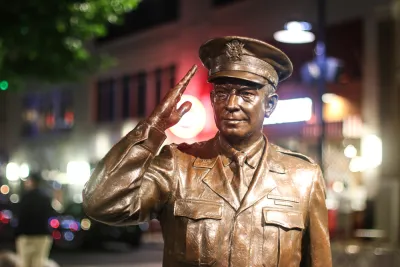The idea for the Eisenhower was approved by Congress in 1999, and though the opening date for the Frank Gehry-designed memorial was delayed from May 2020, the public will finally get a chance to see newest memorial in D.C. this September.

Not everything about the new Eisenhower Memorial, designed by Frank Gehry, works, according to an architectural review by Philip Kennicott. "But at night, with the lights on, it is magical."
The Eisenhower Memorial is scheduled to open to the public on September 17, after a pandemic-induced delay from the original planned opening date of May 3, the original opening day falling on the 75th anniversary of the day Allied forces accepted Germany's surrender in World War II.
"Yet with the exception of some trees that need to be replaced, the memorial is essentially finished, and although the public can’t wander through it now, it is easily seen through and above the surrounding fence," reports Kennicott.
After catching the reader up on some of the setbacks during a design process undertaken in several iterations by Gehry, one of the most famous architects in the world, after the memorial was approved in 1999 during the Clinton administration, Kennicott turns the attention of the article of an assessment of the new memorial's design merits:
It is unlike any other memorial in Washington, or the world. The design was largely dictated by the awkward site, a four-acre patch of land just south of Independence Avenue, opposite the Smithsonian’s National Air and Space Museum. The south side of the square is occupied by the U.S. Education Department’s Lyndon Baines Johnson Building, an oblong modernist box with few lovable features. The site is also bisected by Maryland Avenue, which offers a particularly fine view of the U.S. Capitol, a view that preservationists and oversight groups felt had to be protected.
Gehry’s response to the site was deft and daring. He proposed a giant screen, dubbed a tapestry, along the south edge, effectively veiling the Education Department. The idea of a metal tapestry with a representational image on it was both a reference to an earlier memorial tradition — woven-cloth tapestries were used for centuries to glorify emperors, kings, the victors in battle — and a radical departure from the tradition of using solid stone as the essential medium for monuments. But the tapestry also allowed Gehry to create a parklike space in front of it, a little green oasis in a part of the city that is famous mainly for its dispiriting bureaucratic architecture.
The key notes of praise, however, are found in Kennicott's description of the memorial as experienced at night, where the scene becomes magical. And, yes, the source article has photos of the real thing.

Analysis: Cybertruck Fatality Rate Far Exceeds That of Ford Pinto
The Tesla Cybertruck was recalled seven times last year.

National Parks Layoffs Will Cause Communities to Lose Billions
Thousands of essential park workers were laid off this week, just before the busy spring break season.

Retro-silient?: America’s First “Eco-burb,” The Woodlands Turns 50
A master-planned community north of Houston offers lessons on green infrastructure and resilient design, but falls short of its founder’s lofty affordability and walkability goals.

Test News Post 1
This is a summary

Analysis: Cybertruck Fatality Rate Far Exceeds That of Ford Pinto
The Tesla Cybertruck was recalled seven times last year.

Test News Headline 46
Test for the image on the front page.
Urban Design for Planners 1: Software Tools
This six-course series explores essential urban design concepts using open source software and equips planners with the tools they need to participate fully in the urban design process.
Planning for Universal Design
Learn the tools for implementing Universal Design in planning regulations.
EMC Planning Group, Inc.
Planetizen
Planetizen
Mpact (formerly Rail~Volution)
Great Falls Development Authority, Inc.
HUDs Office of Policy Development and Research
NYU Wagner Graduate School of Public Service


























